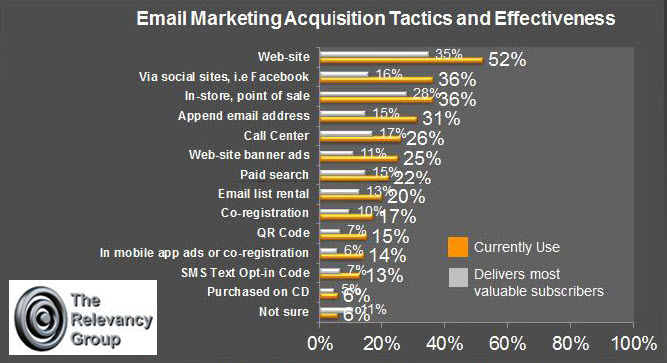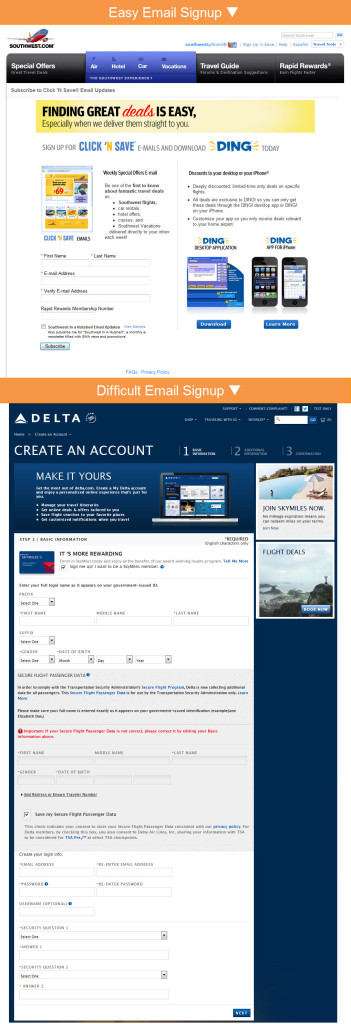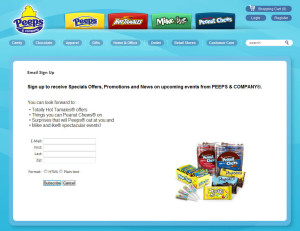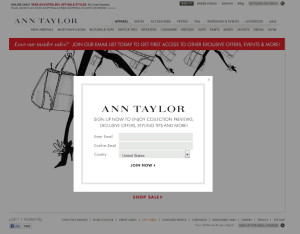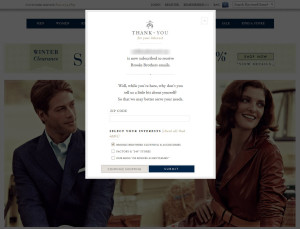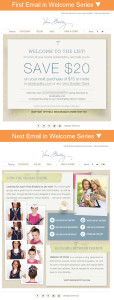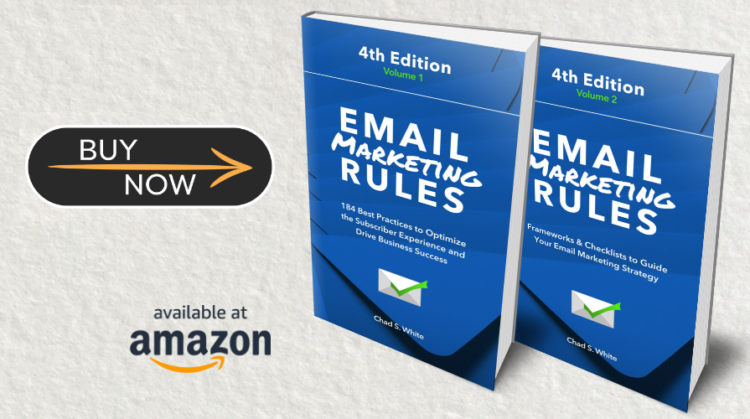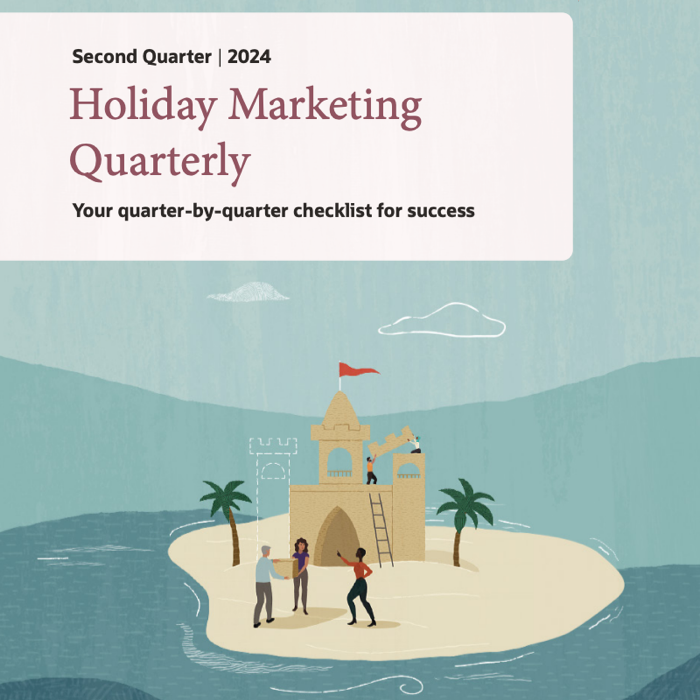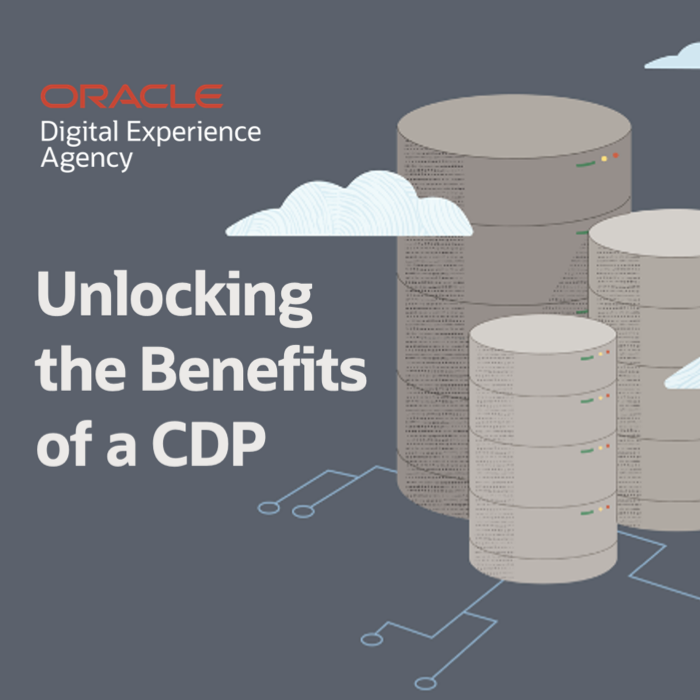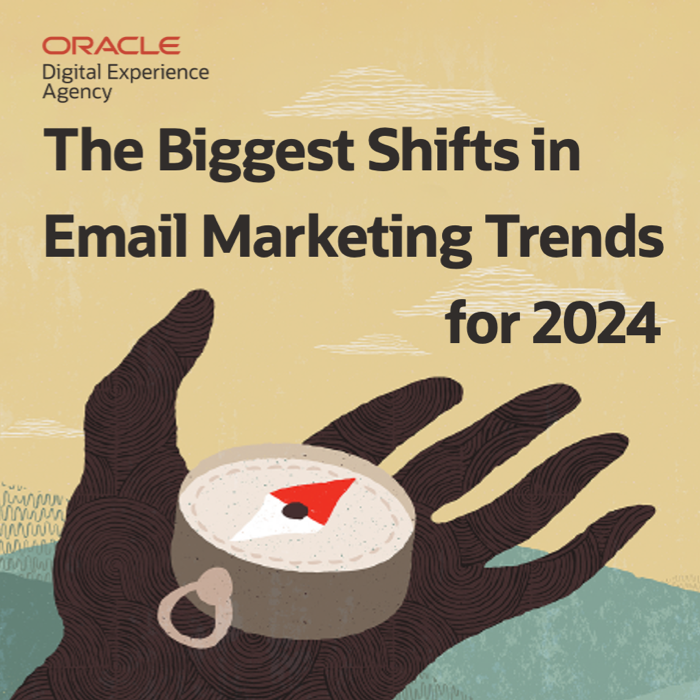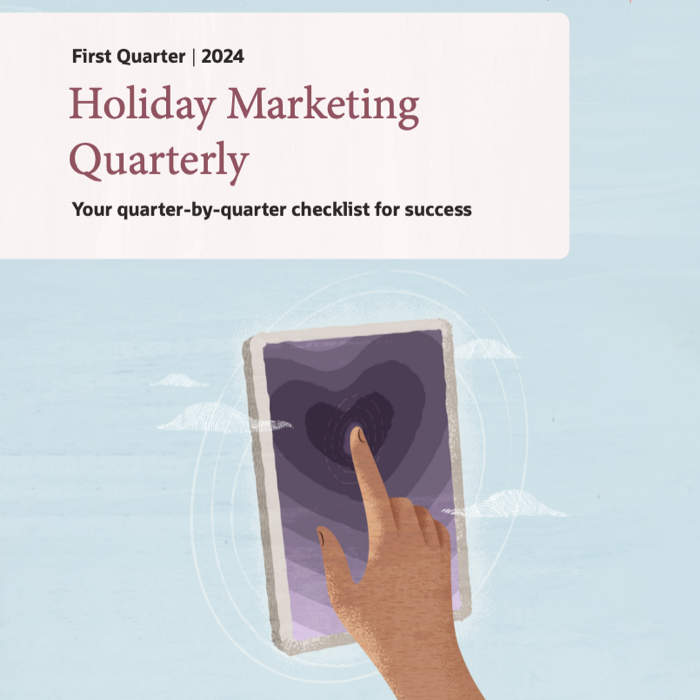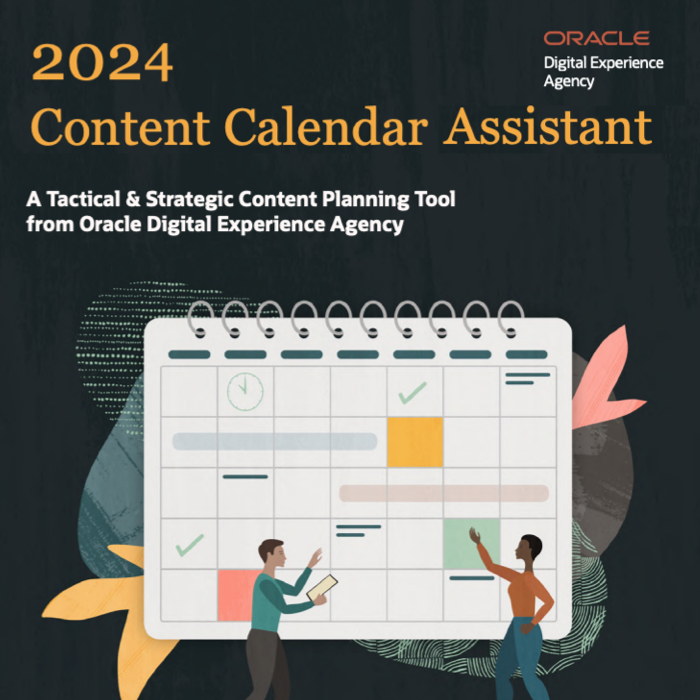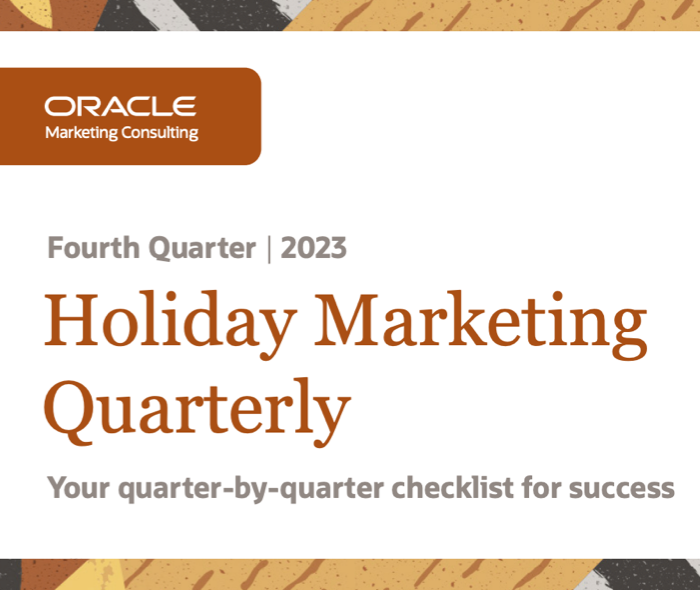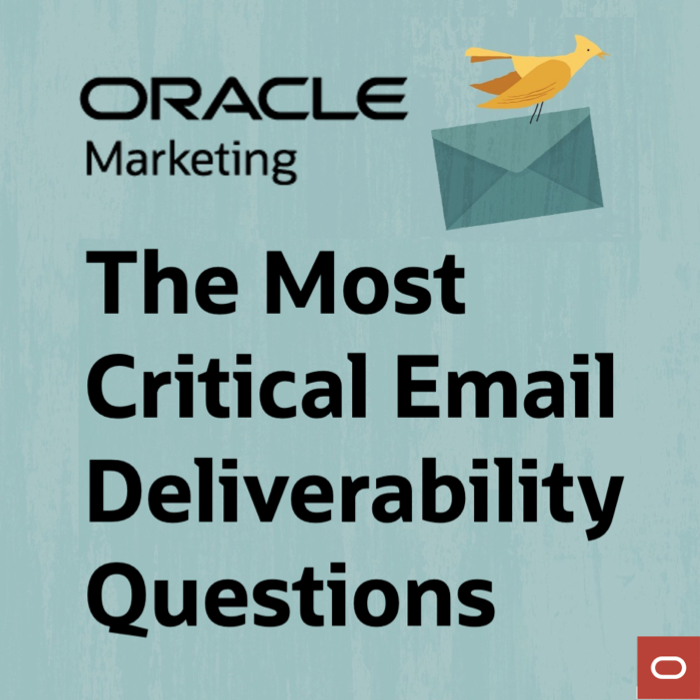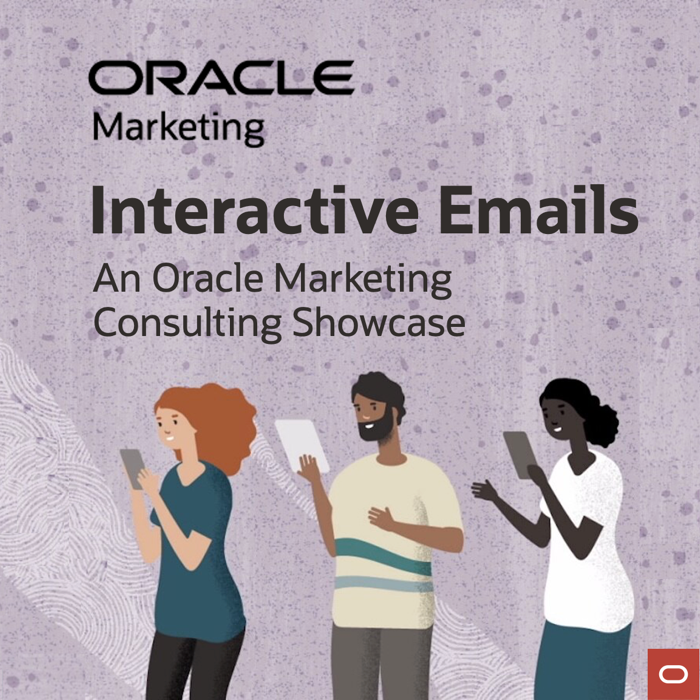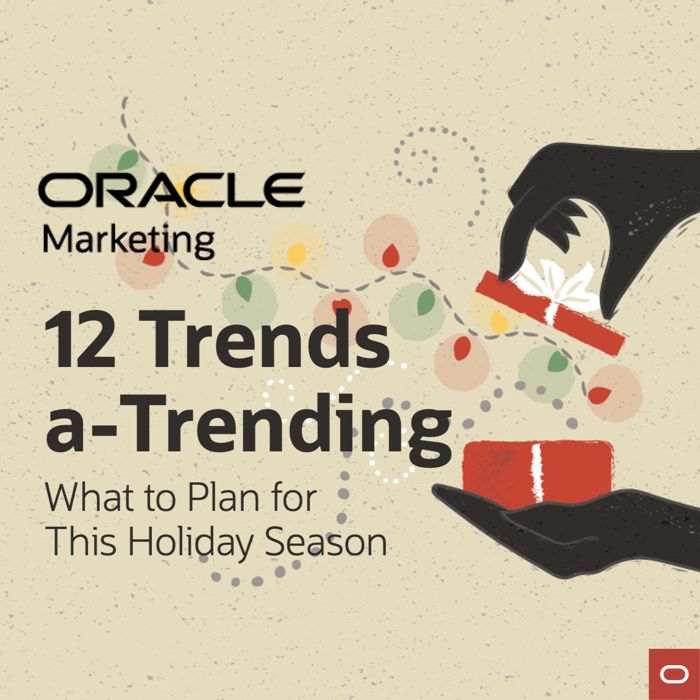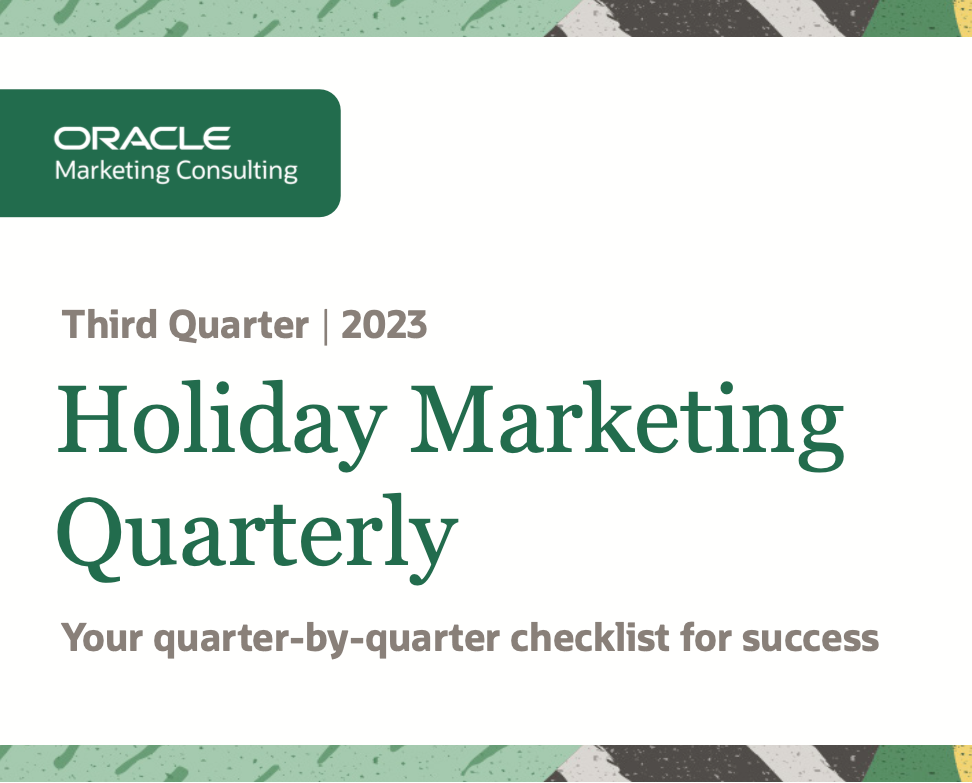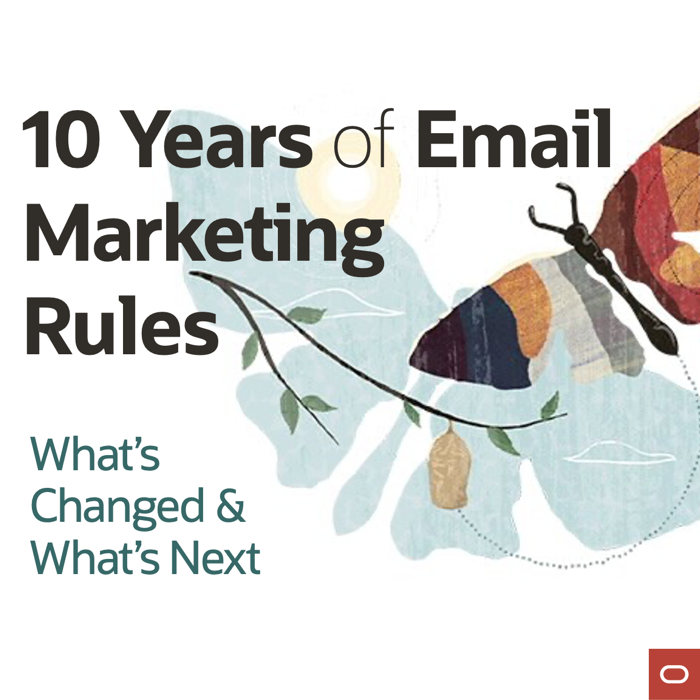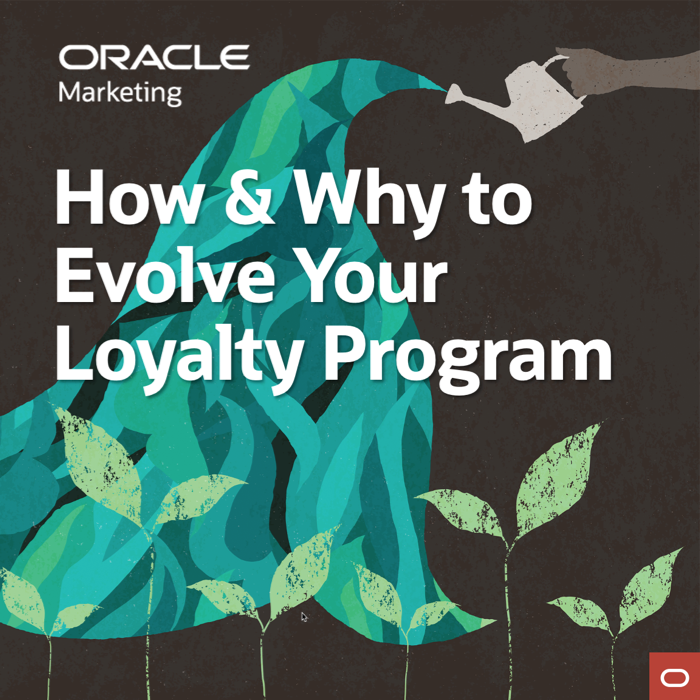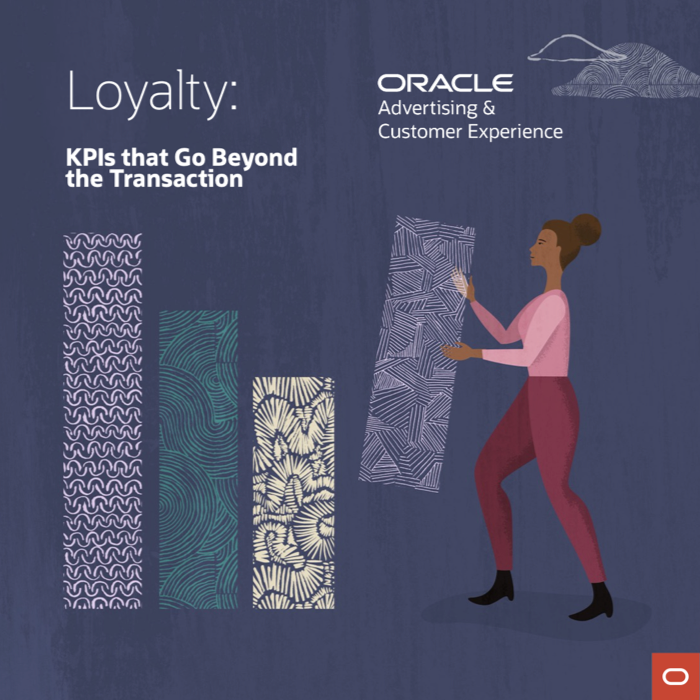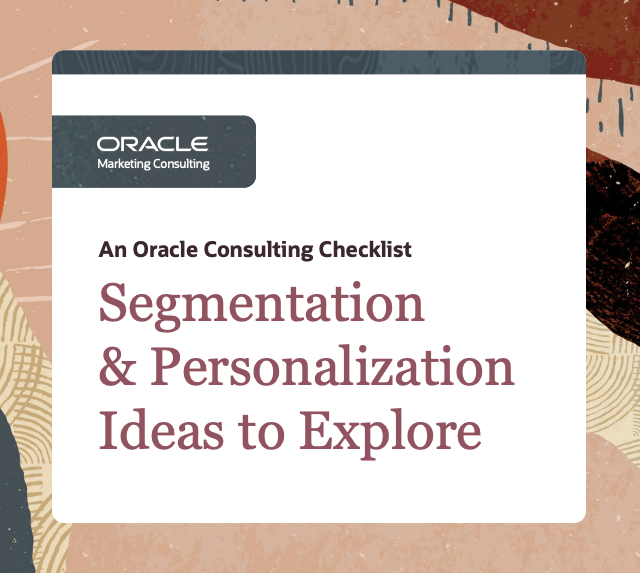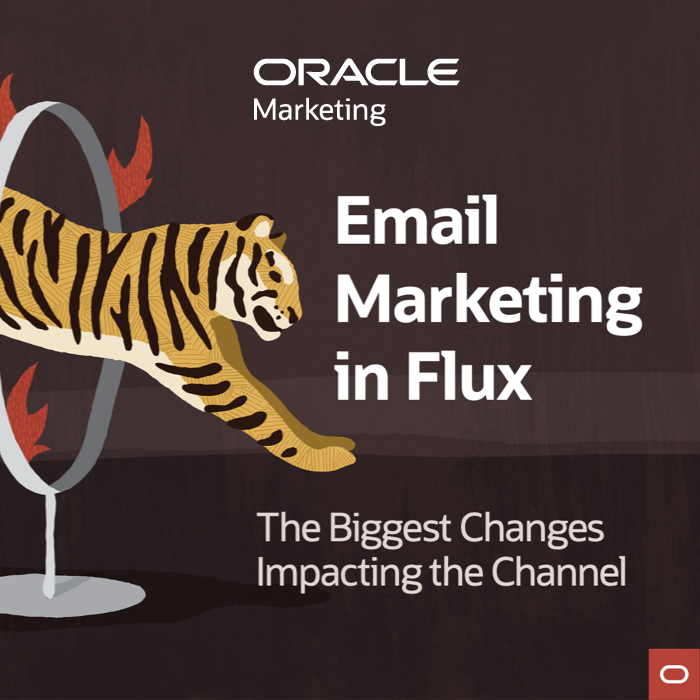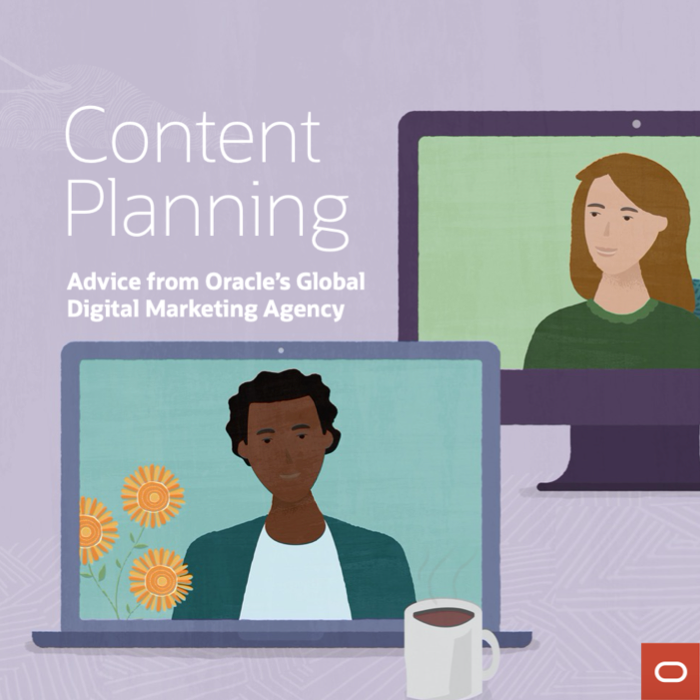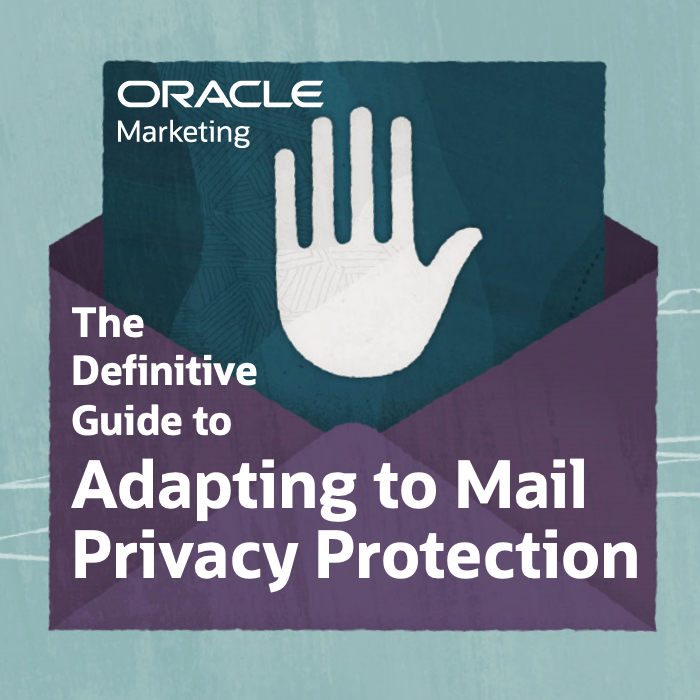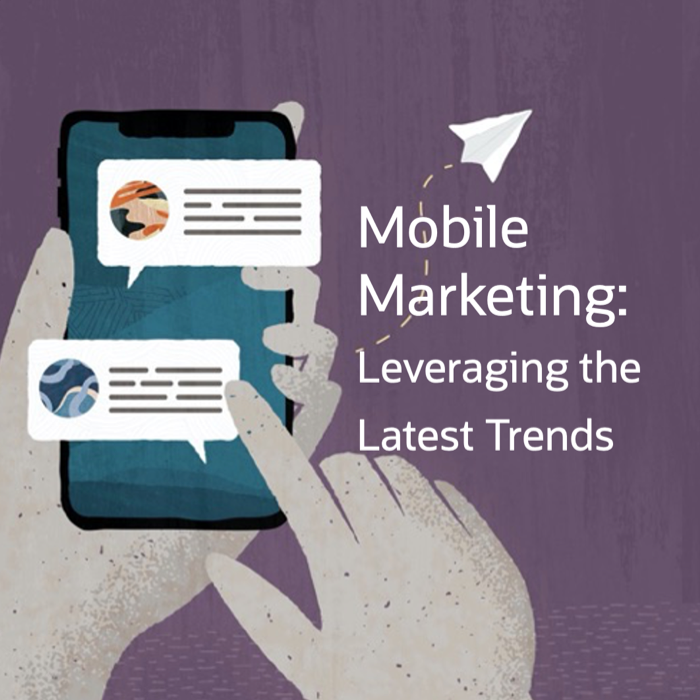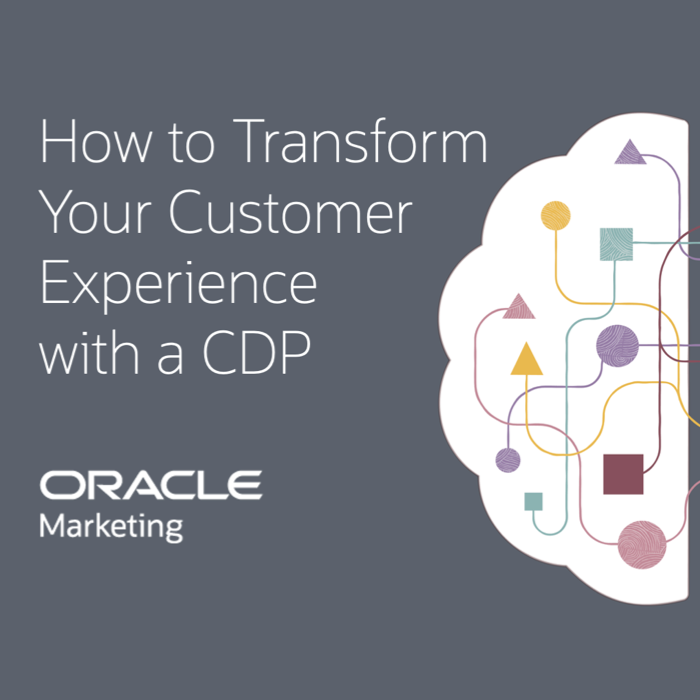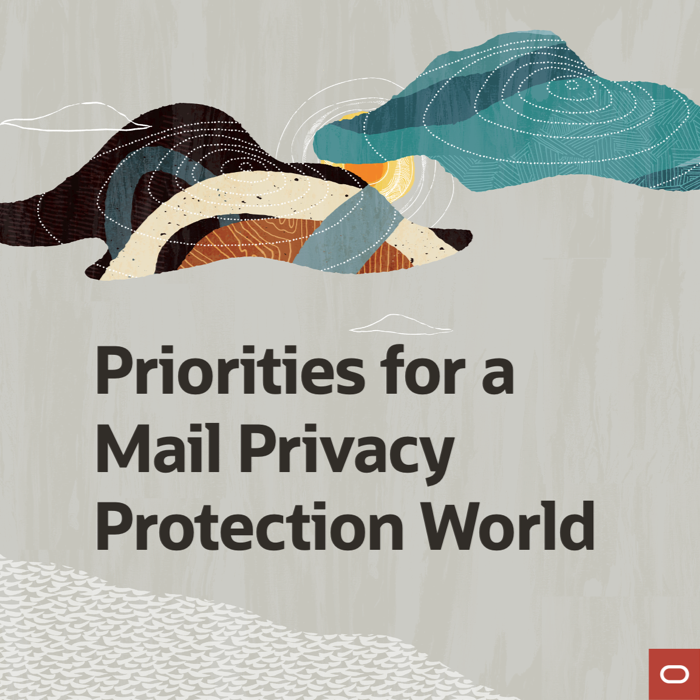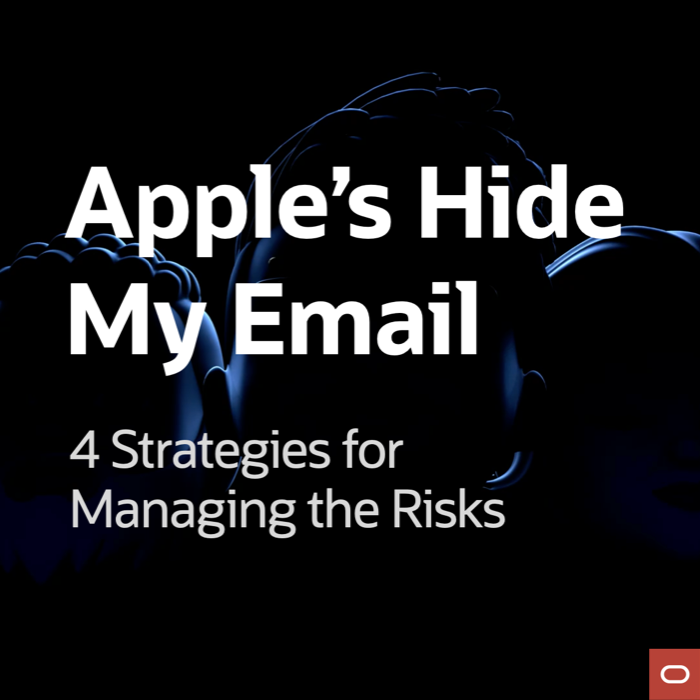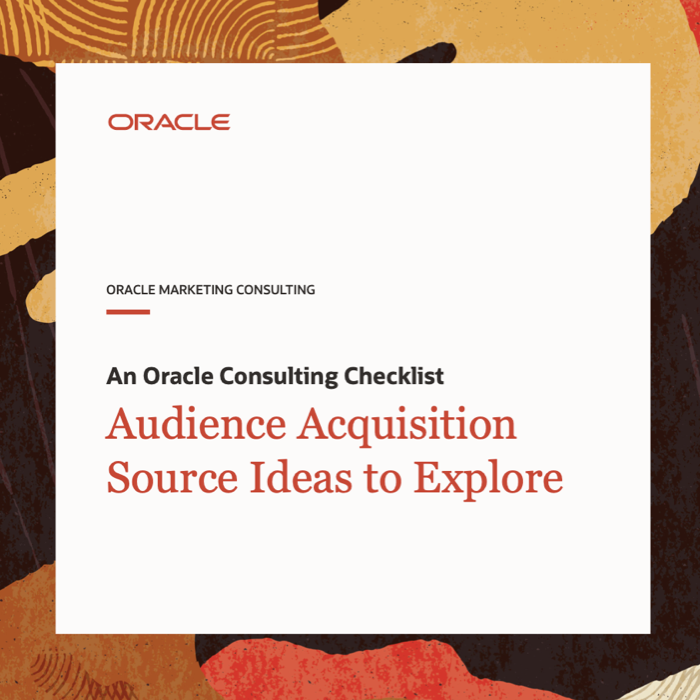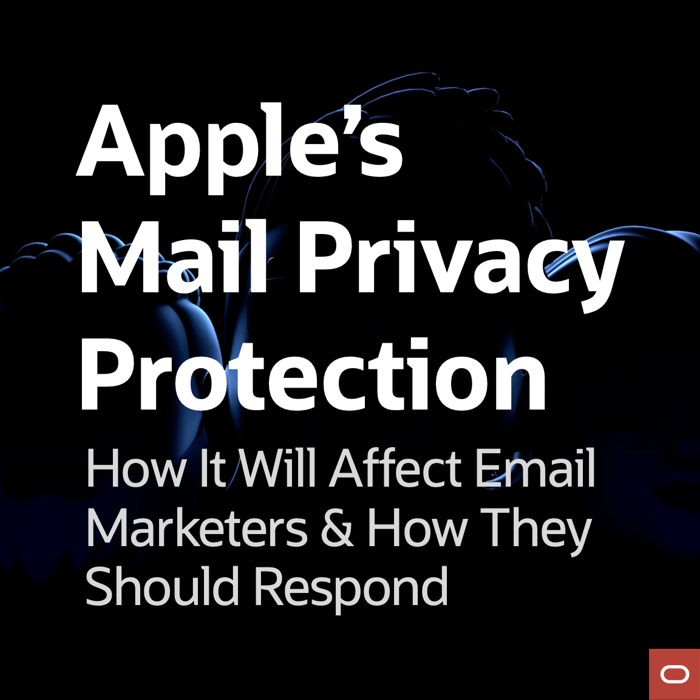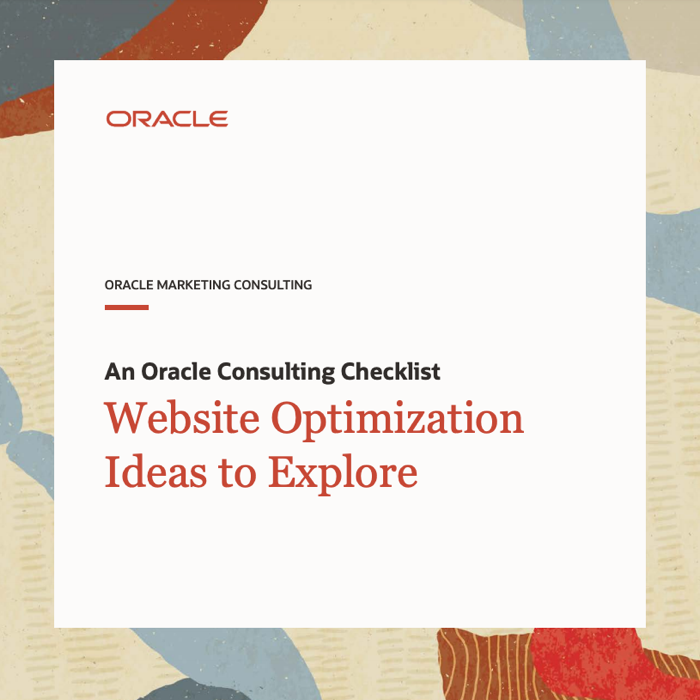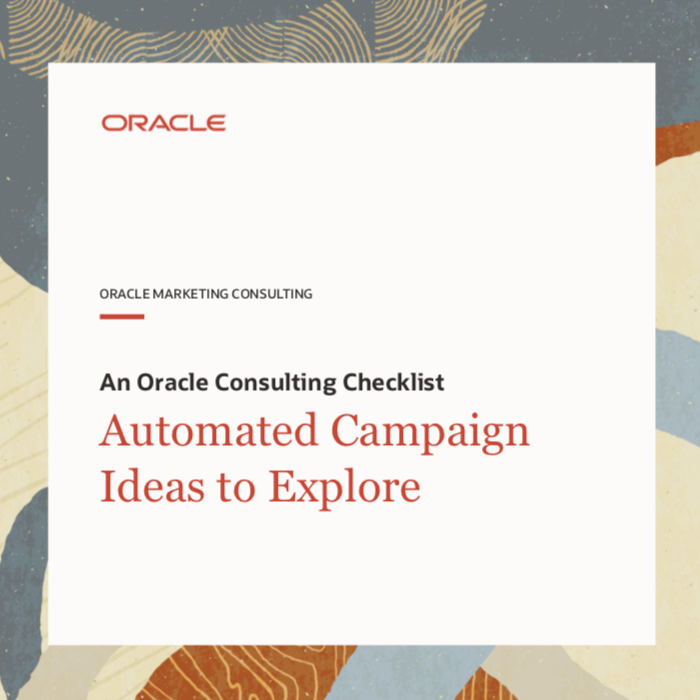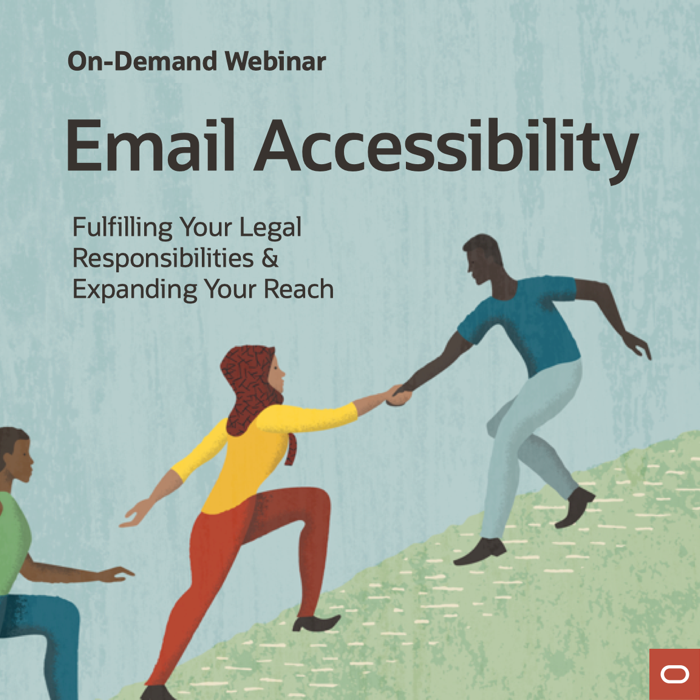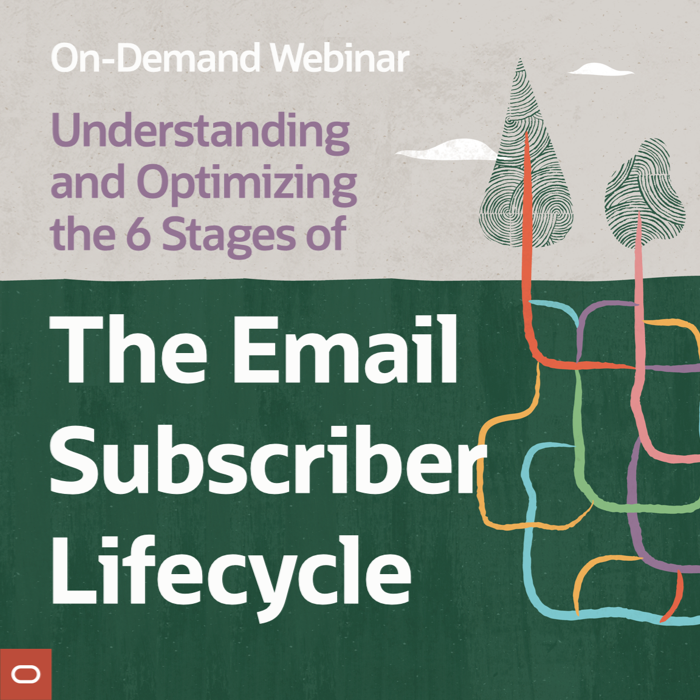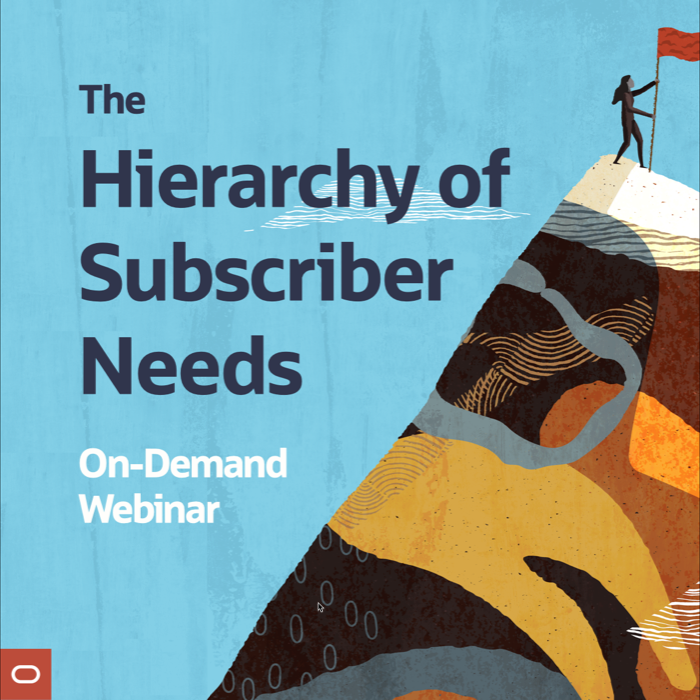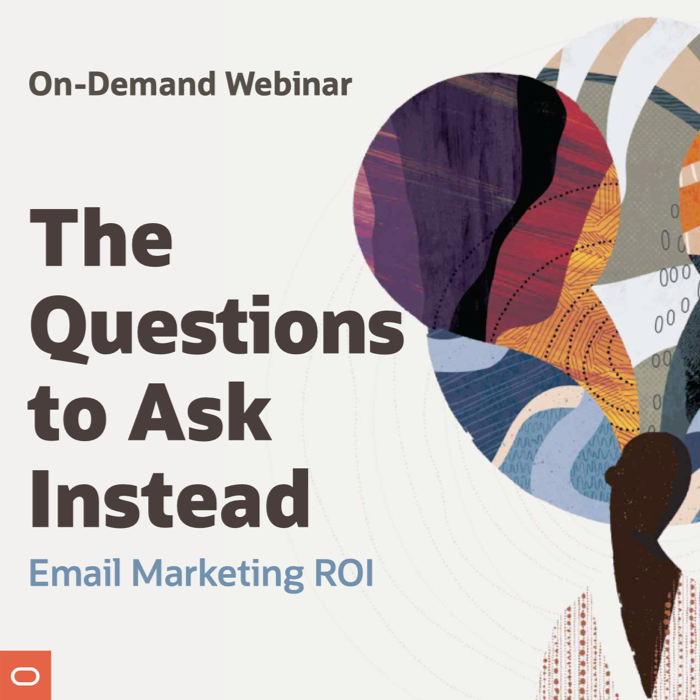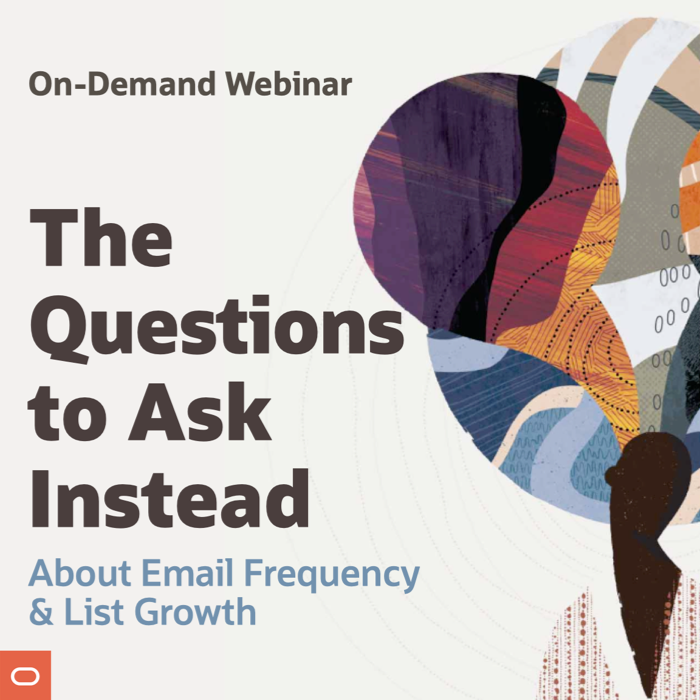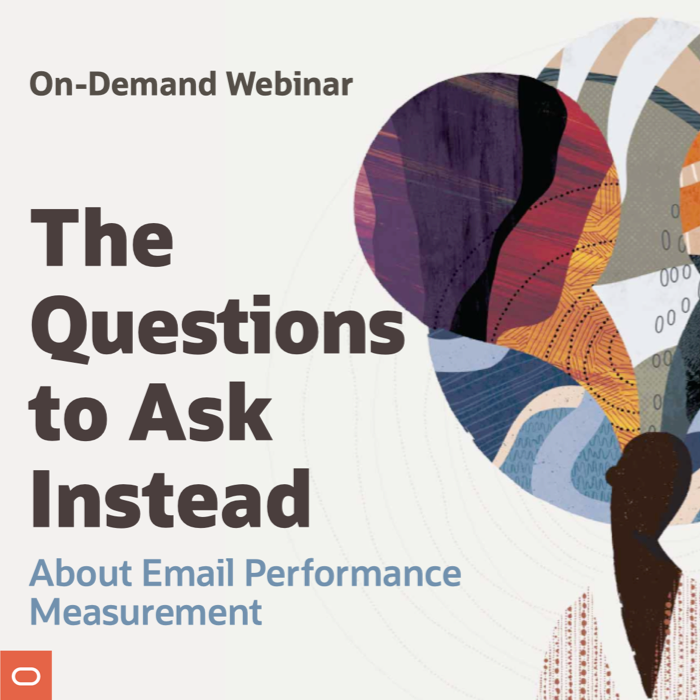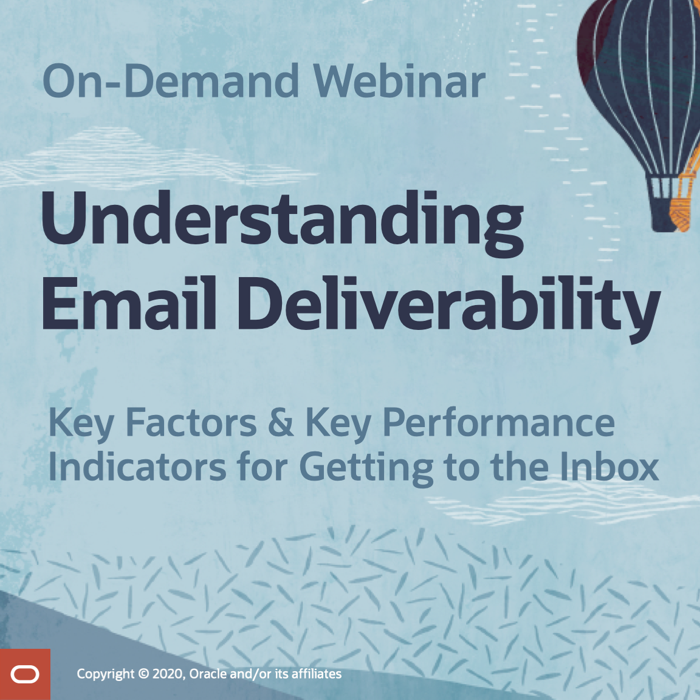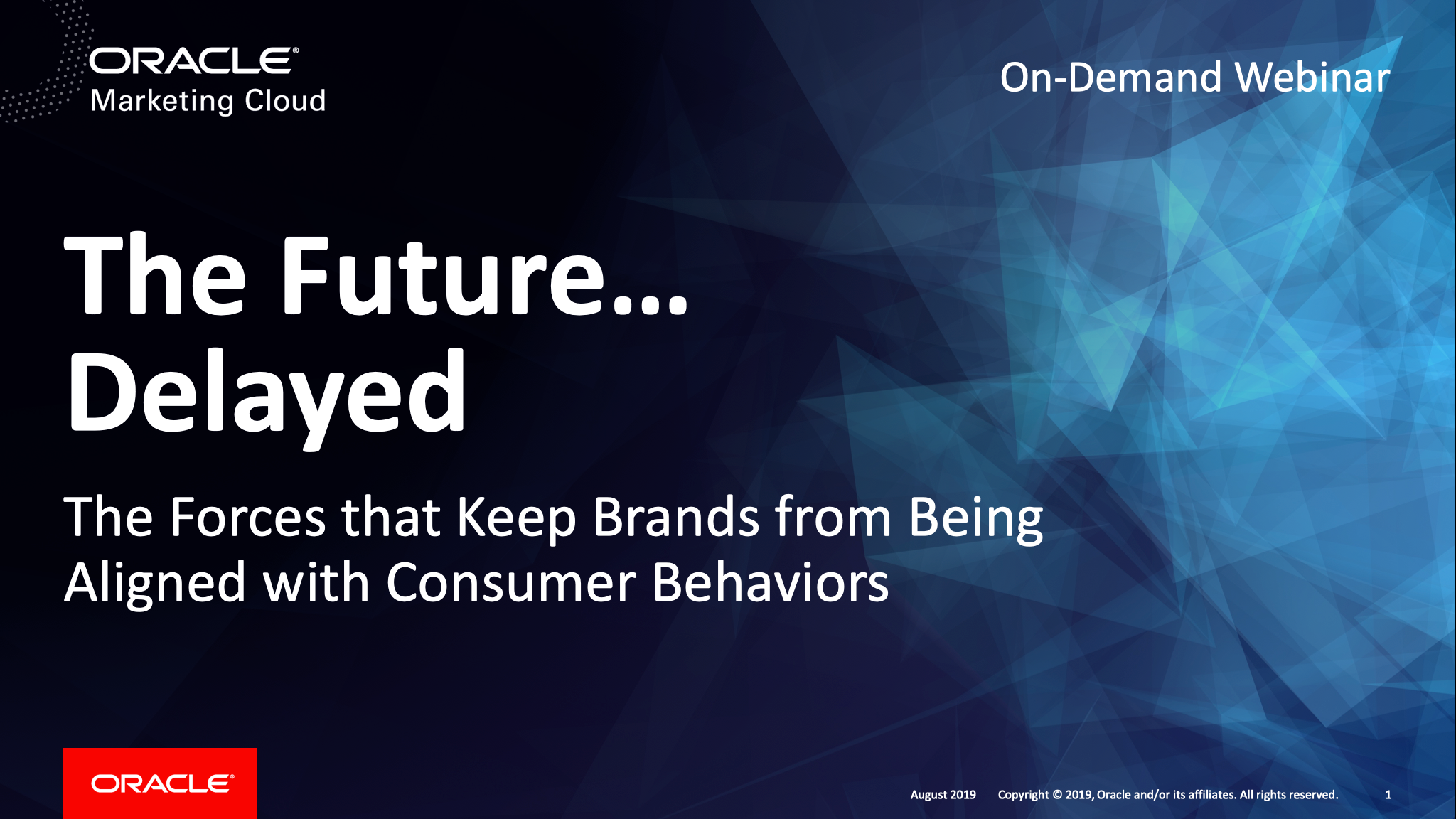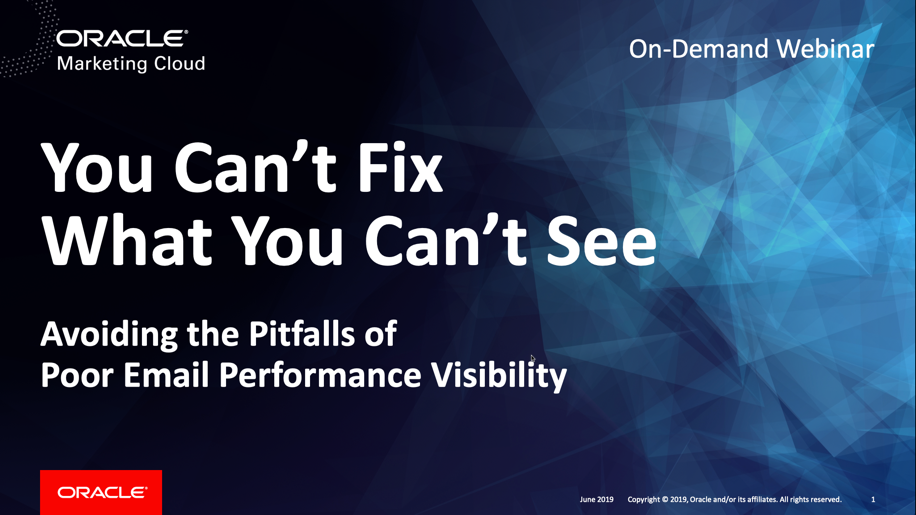Yahoo Mail Hacking Reveals Do-Not-Reply Failures
Posted on April 9, 2013
Much has been written about all the Yahoo Mail accounts that have been hacked in recent months. One of my tracking accounts was among those hacked and hijacked into sending a spam email to each of the contacts in my address book—which was full of sender addresses used by retailers to send promotional email.
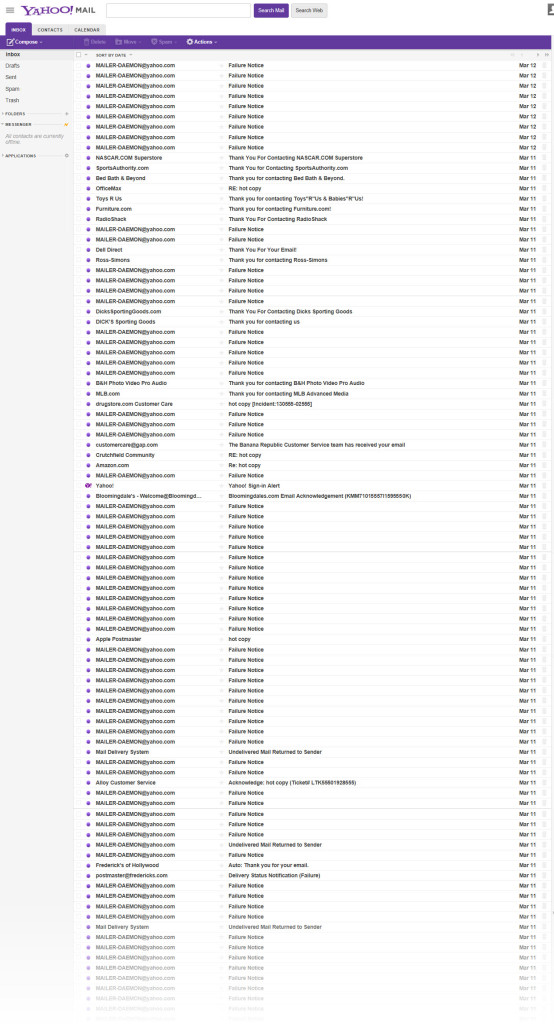 The resulting stream of “Failure Notice” messages made for a poignant commentary on the practice of using do-not-reply email addresses and mailboxes that don’t accept email. Even the “Thank you for contacting us” replies were mostly just messages saying that you reached an unmonitored inbox and instructing you to contact them by other means. Only a handful of brands including Alloy, Banana Republic, Crutchfield and Drugstore.com confirmed receipt of the message and said they’d reply (which none of them did considering it was obviously spam).
The resulting stream of “Failure Notice” messages made for a poignant commentary on the practice of using do-not-reply email addresses and mailboxes that don’t accept email. Even the “Thank you for contacting us” replies were mostly just messages saying that you reached an unmonitored inbox and instructing you to contact them by other means. Only a handful of brands including Alloy, Banana Republic, Crutchfield and Drugstore.com confirmed receipt of the message and said they’d reply (which none of them did considering it was obviously spam).
In the past, opponents of do-not-reply addresses have argued that they’re subscriber-unfriendly, that they send the message that it’s okay for the marketer to email the subscriber but not vice versa. Making it impossible to easily reply to messages eliminates interactions that might otherwise occur, which is a detriment to the marketer and their brand. Those points continue to be true.
However, over the past year or two, a new reason has emerged to ditch the do-not-reply address and start monitoring the replies to your promotional messages: deliverability. ISPs now factor in engagement metrics when determining whether to deliver, junk or block your emails. So if your subscribers open, scroll through, click, mark as important, forward, reply to or otherwise interact with your emails, then your future emails are more likely to be welcome.
While monitoring promotional email sender address accounts can be a chore because of all the spam and out-of-office auto-replies they get, more tools are now available to separate the signal from the noise.
So if you’re still using a do-not-reply address, you now have one less reason to keep using it and one more reason to make the switch.
The Many Gradations of Mobile Email Design
Posted on April 4, 2013
With mobile email reading now beyond the critical mass stage for nearly every brand, marketers are finally making creating mobile-friendly emails a priority. According to a MarketingSherpa survey, it’s an even greater priority than integrating email and social, which I think is very appropriate and overdue.
 My design colleagues here at ExactTarget just released Designing for the Mobile Inbox, a report that gives a great overview of the need for mobile email design and discusses the basics of mobile aware design and responsive design and how they’re different from desktop-centric design.
My design colleagues here at ExactTarget just released Designing for the Mobile Inbox, a report that gives a great overview of the need for mobile email design and discusses the basics of mobile aware design and responsive design and how they’re different from desktop-centric design.
While it’s helpful to think of email design as falling into those three major buckets, there are actually intermediary steps along the way from desktop-centric design to truly responsive design, and many of the brands I watch are definitely taking intermediary steps:
1. Desktop-Centric Design: Traditional design that’s wide for viewing on desktop and laptop monitors and small links and buttons that are intended for clicking on with a cursor
By my estimation, most marketers are still here at square one.
2. Quasi-Mobile Aware Design: The primary and secondary messages use images and buttons that are mobile-friendly, but the header, navigation bar and footer are still desktop-centric
This is the first step that many marketers take toward being mobile-friendly. Rather than overhaul their entire template, they’re improving the content that changes from email to email. Uncommon Goods is a good example of this approach. Their primary and secondary messages are mobile aware, but their navigation bar and footer aren’t touch-friendly yet.
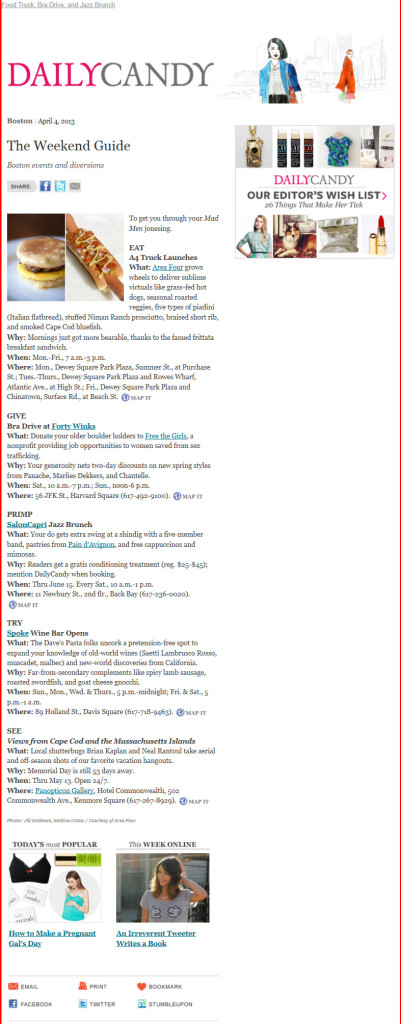 3. Mobile Aware Design: A single email design that works pretty well on both desktops and mobile devices
3. Mobile Aware Design: A single email design that works pretty well on both desktops and mobile devices
Skinny designs fall into this category. I like the creative approach taken by Daily Candy, which makes the entire right-hand side of their emails expendable in case it’s clipped by a small screen.
Spacious designs—with large images, large type and large buttons—that look good on tablets but scale down nicely for smartphones also fall into this category. Lowe’s emails are a good example of this approach.
4. Fluid, Liquid or Scalable Design: Expanding or contracting to fill the screen size, the design keeps everything on the screen to avoid the need for pinching on touchscreens
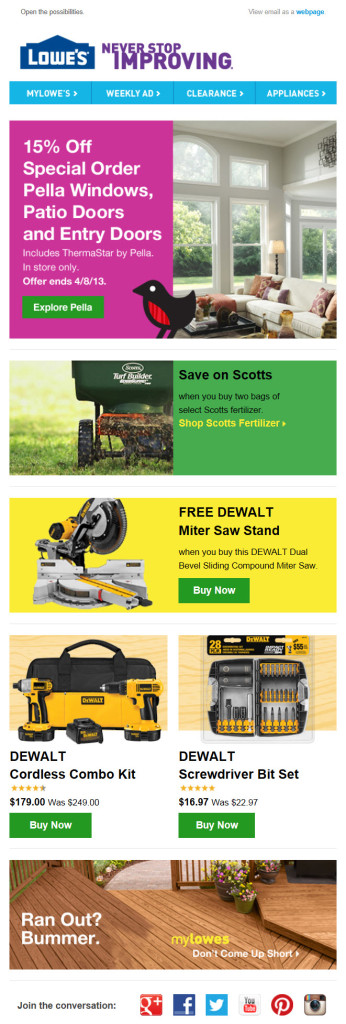 5. Adaptive Design: The design generally uses one or two pixel-width “breakpoints” that correspond to typical screen sizes for smartphones, tablets and desktops to trigger content changes and reformatting so reading the content is optimized for those screen sizes
5. Adaptive Design: The design generally uses one or two pixel-width “breakpoints” that correspond to typical screen sizes for smartphones, tablets and desktops to trigger content changes and reformatting so reading the content is optimized for those screen sizes
This flavor of design is often lumped into responsive design, although it’s technically simpler and more predictable in terms of rendering. For instance, we recently called this Starwood email and this REI email responsive when they’re actually adaptive designs with a single breakpoint that converts the email from desktop-friendly to smartphone-friendly. Many marketers will likely never see the need to improve their email designs beyond this point.
6. Responsive Design: The design format and content dynamically changes based on the screen size
This is held up as the holy grail of email design, but there’s very little true responsive design out there in terms of emails. To get a sense of what responsive design can do, just adjust your browser window when reading my blog, which is fully responsive. You’ll see the size of the images and text change dynamically, as well as the content reorient itself, all the way down to a screen width of just 180 pixels.
How mobile-friendly are your email designs currently and which flavor of mobile email design are you aiming for in the future?
The Last Word on March 2013
Posted on April 2, 2013
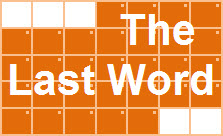 A roundup of articles, posts, tweets and emails you might have missed last month:
A roundup of articles, posts, tweets and emails you might have missed last month:
Must-read articles, posts & whitepapers
Responsive email design (#RED)
Marketers Push to Take Email Mobile
Marketing In The Age Of The Inbox Within The Inbox
Using a Popover as an Acquisition Tactic
Triggered Emails Secure Higher Open Rates, Engagement
Insightful & entertaining tweets
@stylecampaign: Anyone….how are they doing this? http://t.co/VkoivrrJzL v @alexcwilliams
@stylecampaign: Great @alexcwilliams already figured it out http://t.co/qSMYl0eKNK (cheers!)
@jackexmachina: Just received an invite to a “mobile email master class” that looked like junk on my phone. What is this, amateur night?
@AdamTSutton: At the end of the day, all that matters… is slapping yourself for #cliche copy
Great additions to the Email Swipe File pinboard
Zulily welcome email series sent during Q1 of 2013 >>View the pin
Warby Parker triggered email sent in 12/2012 >>View the pin
The White House email sent 3/15/13 >>View the pin
Anthropologie email sent on 3/15/13 >>View the pin
Noteworthy subject lines
Horchow, 3/4 — #ThenAndNow video with Roger and Sally Horchow + Friends & Family starts tomorrow!
ModCloth, 3/28 — Our most ‘Pinteresting’ pieces + wedding-worthy frocks!
Zazzle, 3/22 — Make your own Zazzle products with Instagram!
Container Store, 3/29 — Do you know what’s in your fridge?
Michael’s, 3/4 — March is National Craft Month. What will you make?
West Elm Market, 3/22 — Blue, yellow, red or orange?
UnderArmour, 3/28 — It Won’t Be Cold Forever.
Wayfair, 3/27 — ✿Floral bedroom decor, patio set upgrades, hosting essentials, bedroom under $400, living room furniture and more
DCCC.org, 3/22 — Mitch McConnell actually said this:
Karmaloop, 3/19 — Extended! KL Code: CELTIC
Neiman Marcus, 3/6 — Dress for the Year of the Snake
Tiny Prints, 3/28 — The 2013 Grad Collection Is Here!
SkyMall, 3/28 — From Now Until Opening Day, Save 25% at SkyMall!
ThinkGeek, 3/22 — ThinkGeek’s sorry you couldn’t go to PAX…
Lululemon Athetica, 3/26 — yoga on the rocks
Etsy, 3/16 — ROYGBIV
Urban Outfitters, 3/18 — One Thousand Shoes & Counting!
ASPCA, 3/15 — Top Five Pet Poisons of the Year
Walgreens, 3/4 — Say hello to Britain’s #1 beauty secret | 20% OFF Contacts
Most popular posts on EmailMarketingRules.com
1. The Email Marketing Rules Book Is Now Available!
2. Quarter of B2C Marketers Send a Welcome Email Series
3. More Brands Sending Welcome Emails, But Opportunities Remain
The Higher Bar for Browse Abandonment Emails
Posted on March 21, 2013
Because of their high ROI, cart abandonment emails are growing in popularity, although only 20% of retailers are using them, according to recent research. Adoption is even lower for browse abandonment emails, which are emails that are triggered in response to a subscriber browsing your website but not purchasing anything. However, that lower usage rate is to be expected because browse abandonment is intrinsically more complicated because the subscriber’s intention is much less clear.
With a cart abandonment, the subscriber has made their product choice or at least seriously narrowed it. But with a browse abandonment, it’s significantly much less clear if they product they last viewed was a great interest to them or not. Browsing can just as easily indicate directional product category interest as it can interest in a specific product.
Because of that, it leads to many potential questions: Did the subscriber like the product but just isn’t ready to buy? Did they like the product but were unsure if it was a good deal? Were they unsure if it had all the features they needed? Were they unsure about the product’s quality?
In a store, a shopper could ask an associate for more information and the associate would be able to ask questions to help the shopper come to a decision. Recreating those interactions in an email is challenging but increasingly feasible.
The evolution of Williams-Sonoma’s browse abandonment email program is a great example of how these emails have become more sophisticated. Williams-Sonoma was one of the earliest adopters of browse abandonment emails, sending them as early as 2009. Back then they acted like many of the cart abandonment emails do today, reminding the subscriber of the item they browsed and of some of the reasons to shop with the retailer.
Over time Williams-Sonoma recognized that a browser’s interest was less focused than a cart abandoner, so they added some top-rated products to these emails and then later made those additional product promotions more tightly related to the product that was browsed. They also added a “Shop Similar Items” call-to-action to the “Buy Now” CTA for the browsed product. By the end of last year, they were also including banners for seasonal products, like wine for Thanksgiving and Christmas dinners.
In addition to broadening out the messaging, Williams-Sonoma’s program also began to address the different reasons for abandonment more specifically. For instance, if an out-of-stock product was browsed, they made the logical assumption that you might be interested in purchasing it when it’s back in stock and send you a notification when it is.
And there’s certainly more room to up the sophistication further. Crutchfield’s browse abandonment program is my favorite. They have different ones set up to address subscribers who browse different product categories like HDTVs, Blu-Ray players, stereo receivers, 6-3/4” speakers, and DSLR cameras, as you can see in this example. It was sent in response to me browsing the Nikon D5100. You can see how they used that information as a starting point but went well beyond it to get at what my needs and concerns might have been, just like a good store associate would have done.
Quarter of B2C Marketers Send a Welcome Email Series
Posted on March 14, 2013
Not only are more B2C marketers sending welcome emails, more are sending welcome email series. The first weeks of an email marketing relationship are the most critical, so they deserve the extra attention that a welcome email series can provide.
Twenty-five percent of marketers send a welcome email series, according to ExactTarget research involving more than 160 B2C brands, including retailers, restaurants, manufacturers, travel and hospitality, and nonprofits. Of those marketers that send welcomes, 31% send a welcome email series rather than a single welcome email.
With 30% of retailers sending a welcome email series, they are nearly twice as likely as non-retailers to do so. And the percentage of retailers sending a welcome email series has tripled since 2009.
Many welcome email series included three emails, but a few included as many as five. Most of the emails in these series were interspersed with the brand’s usual promotional emails rather than all sent sequentially.
The messaging in each of the emails generally was one of the following:
- Promotional welcome offer, which tended to be a percentage-off or free shipping offer
- Reminder of soon-to-expire welcome offer
- Touting private label goods
- Follow us on social media
- Download our mobile app
- Explanation of website features and tools
- Introduction of store services
Welcome email series are even more powerful when you tailor them to different subscribers based on how they joined your email list (homepage, store, etc.) or their previous interactions with your brand.
Below are six of my favorite welcome email series from Barney’s, Crate & Barrel, eBags, Target, Vera Bradley and Zulily.
More Brands Sending Welcome Emails, But Opportunities Remain
Posted on March 12, 2013
Welcome emails are among the top-performing emails that a marketer can send, so I was happy when my latest research found that more brands than ever are sending them. However, a closer look uncovered that there are still big opportunities for marketers to get better performance from their welcome emails.
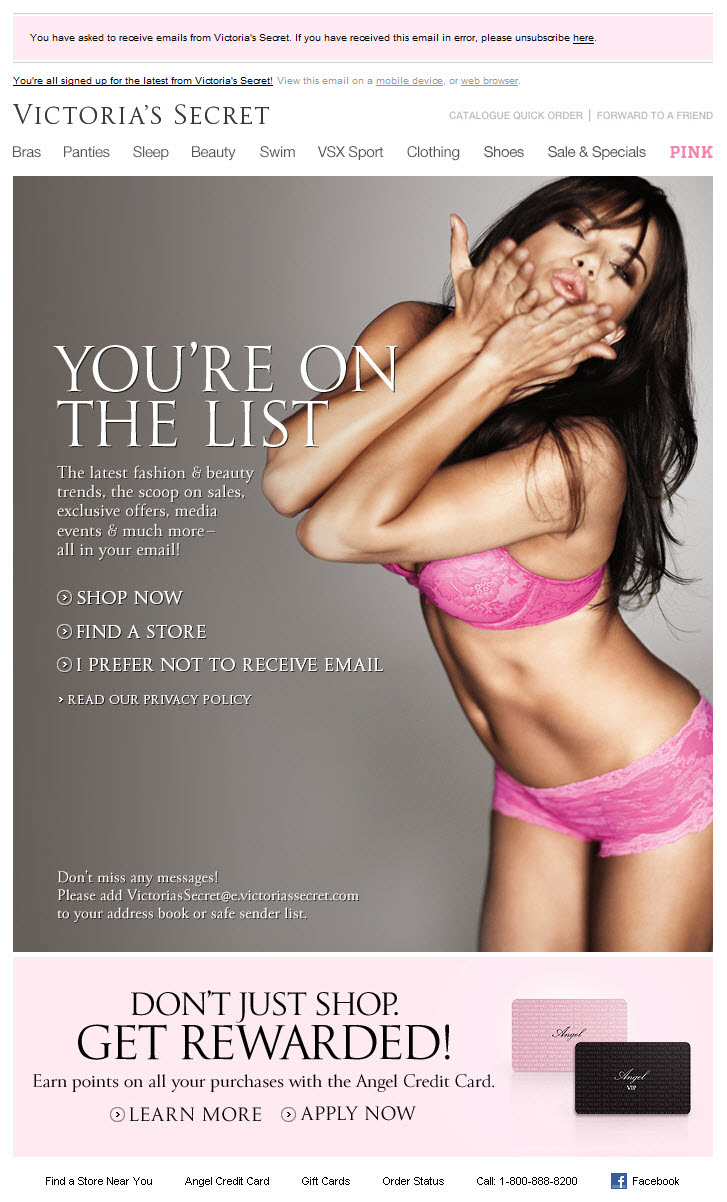 Nearly 81% of B2C marketers send welcome emails to their new subscribers, according to ExactTarget research involving more than 160 B2C brands, including retailers, restaurants, manufacturers, travel and hospitality, and nonprofits.
Nearly 81% of B2C marketers send welcome emails to their new subscribers, according to ExactTarget research involving more than 160 B2C brands, including retailers, restaurants, manufacturers, travel and hospitality, and nonprofits.
Retailers are considerably more likely than non-retailers to send a welcome email, with nearly 87% of retailers sending one versus only 70% of non-retailers. When I last looked at retailers’ welcome email practices in 2009, more than 74% were sending welcome emails, so adoption has grown significantly among that group.
Although adoption has increased, the effectiveness of welcome emails is still dampened by a couple of factors.
First, some marketers don’t send their welcome emails immediately after signup, when subscribers are most likely to open and act on them. For example, welcome emails from Applebee’s, West Elm and several other brands took 3 or more days to arrive. And Victoria’s Secret’s welcome email didn’t arrive until 2 weeks after signup. Delaying the delivery of your welcome email drastically reduces its effectiveness.
And second, a number of marketers also sent welcome emails that rendered poorly, including the ones from Tide and Drs. Foster & Smith. Because welcome emails are key to delivering a good first impression, make sure that yours renders well—with and without images enabled. Because ISPs change their coding support without notice, it’s wise to periodically confirm that your welcome and other triggered emails are still displaying as intended.
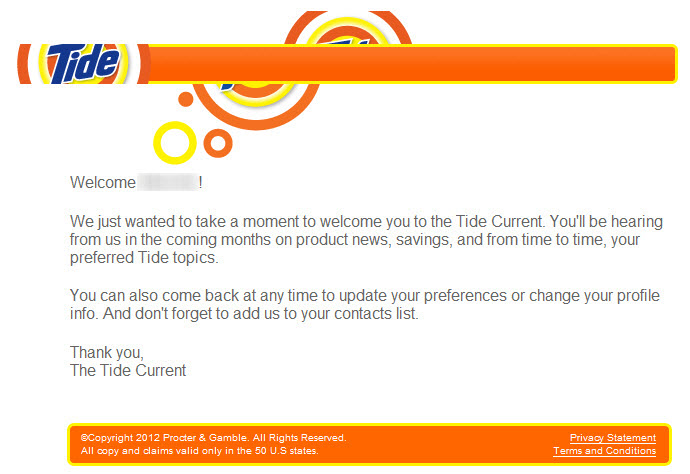 On the plus side, marketers have gotten much better at using their welcome emails to drive action, whether it’s trying to ring up a sale, doing progressive profiling, or exposing new subscribers to their mobile app or social media presence.
On the plus side, marketers have gotten much better at using their welcome emails to drive action, whether it’s trying to ring up a sale, doing progressive profiling, or exposing new subscribers to their mobile app or social media presence.
Marketers are also making their unsubscribe links more prominent in their welcome emails, in case a new subscriber has second thoughts. Recognizing that unsubscribes are way preferred over spam complaints, brands like Victoria’s Secret include opt-out links in the preheader and the primary message block. I was relieved to see that only one brand sent a welcome email that wasn’t CAN-SPAM compliant.
When’s the last time you reviewed and updated your welcome email?
 Email Marketing Rules
Email Marketing Rules